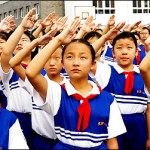Not one to be carried away by the STEM craze, I did find it fascinating in today’s editorial page of the New York Times that the United States is way low on the totem pole on math scores for students. We’re below Latvia, Russia and Spain and a little above Sweden, Israel and Greece.
Shanghai leads the pack while Finland and Canada are in the upper middle.
Why so?
According to the Times, the better scoring countries are more vigorous in their training and selection of teachers, have funding mechanisms that are more equal and have school systems that shun elitism.
Teaching is a respected profession that pays more than it does in the U.S. If you want to get a general idea about how teachers are regarded, read this blog for a dose of sneering and snobbery. Not so in Finland where teachers make just a little more than average salaries. But they are better selected and highly regarded by the Finnish public. Snobbery is out. Educating the poor is as important as teaching the rich.
Canada does not fund its schools according to property taxes the way Americans do. The apple pie method ensures entitlement and disparity since richer communities obviously put more money into schools. The Canadians do it more on a provincial basis and by need so there isn’t the huge spending and resource gap between rich and poor. Likewise, they automatically cut back during bad economic times. In Virginia, teachers are usually the first targeted and among them the first to go are arts, music and physical education teachers.
One of the Gregorian Chants you hear on this blog is that spending has nothing to do with quality. In fact, lots of spending distributed equally has everything to do with quality.
Shanghai led China’s comeback in education after Mao’s zany ideas destroyed it. The Times believes that Shanghai has boosted its students’ performance by making sure that everyone — including the children of migrants — are included. To be sure, there’s plenty of graft and influence peddling in China so that rich kids get prime placement, but one can’t argue with the scores.
Another takeaway: it’s not all about STEM. Although the scores used in these comparisons are based on mathematics, the successful school systems have competent programs in language skill, are, social studies and foreign languages. They have NOT treated their children like robots that need be only programmed to handle a physics experiment or a software program. This is another asinine idea that you get from American think tanks and thoughtless bloggers who shall go nameless.



